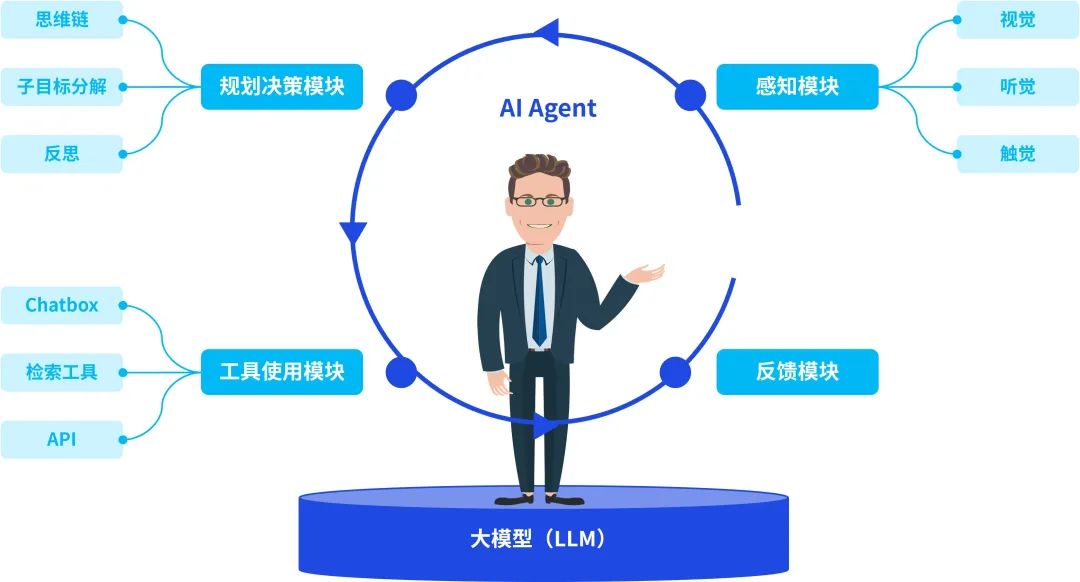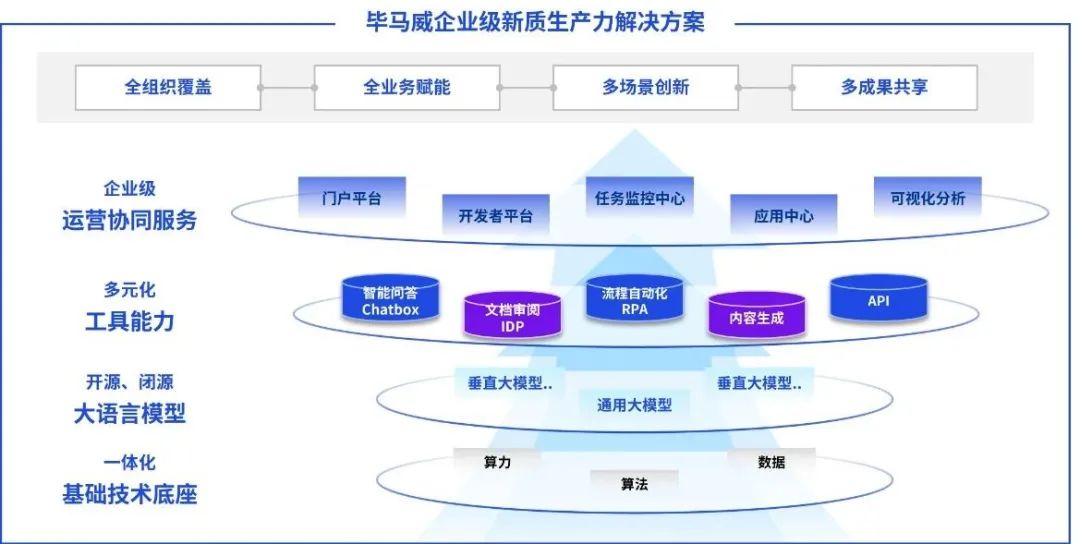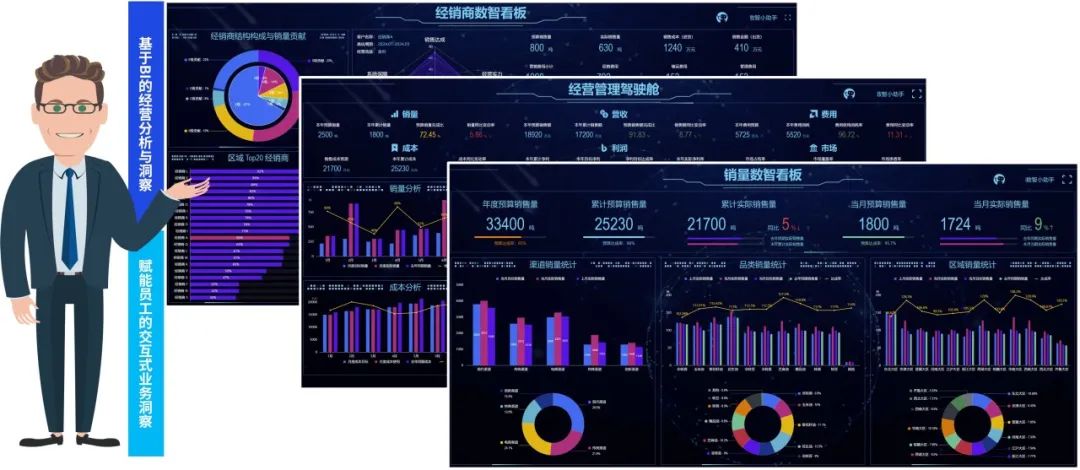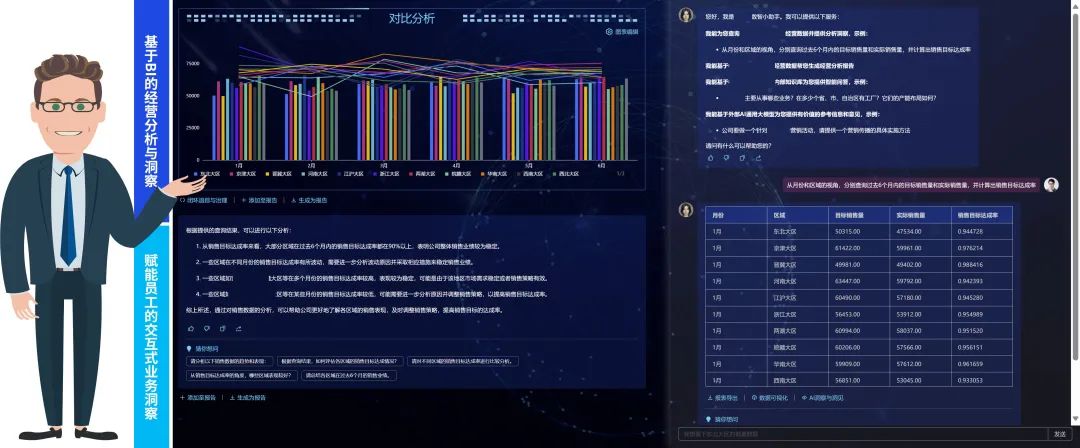
Trends
Tracking
The Heat of New Productivity Remains Unabated, AI Agents Lead the Transformation
Since September 2023, General Secretary Xi Jinping first proposed the term “new productivity” during his visit to Heilongjiang. In the 2024 government work report, it emphasized that “new productivity” has become a key task for this year. Various social entities must accelerate the cultivation of new productivity, promoting qualitative changes in laborers, production materials, production relations, and their optimized combinations through technological innovation, thereby enhancing total factor productivity and creating a new engine for high-quality economic development.
As the large model enters its second half, AI Agents have become the most notable digital technology, representing a necessary path to AGI (Artificial General Intelligence). The concept of an Agent originated in philosophy, describing an entity with desires, beliefs, intentions, and the ability to take action. It was later introduced into the field of artificial intelligence, gaining new connotations—an intelligent entity capable of perceiving and understanding its environment, planning decisions, and forming task orchestration plans without human intervention, ultimately using various tools to achieve established goals. AI Agents independently complete a closed-loop operational chain from demand to execution, from feedback to correction, gradually transitioning from operational layers to management layers, evolving from assistants to experts with efficient and stable working states and self-driven learning capabilities. As multi-Agent collaborative models mature, an increasing number of work scenarios and tasks are being reassigned to these “invisible employees” through human-computer interaction, breaking traditional organizational forms and driving new employment forms and human-machine collaborative relationships towards the final form of new productivity.

As the primary entity in the new productivity initiative, whether enterprises can deeply understand the technological connotations, efficiently implement enterprise-level capability platforms and scenario applications, and promote the leap and transformation of productivity and production relations becomes a key competitive point for enhancing core competitiveness.
Status Quo
Scanning
Enterprises Face Numerous Challenges in Cultivating New Productivity
Enterprise-Level New Productivity is Still in Its Initial Stage
There are three important stages for the implementation of enterprise-level new productivity: the automation stage centered on RPA, the intelligent stage centered on RPA+AI integration, and the human-machine collaboration stage centered on AI Agents. However, most enterprises’ new productivity remains in the automation and intelligent stages, where digital technologies act as passive productivity tools, executing tasks only under clear human directives and rules, with a highly limited level of autonomy and business processing capabilities.
Insufficient Overall Planning of Platform Capabilities
The performance of AI Agents relies on the maturity of large models (LLM), while the diversity and complexity of enterprises’ data present significant bottlenecks affecting performance. Without a flexible “brain,” planning, decision-making, and action capabilities are difficult to ascertain. Moreover, the implementation of AI Agents lacks overall capability planning, and the integration of API ecosystems and external tool capabilities is insufficient, limiting the operability of enterprise-level scenarios.
New Human-Machine Collaborative Models Require Operational Support
As the potential of AI Agents continues to be explored, viewing them solely from the perspective of individual application scenarios cannot support the disruption and transformation of enterprise-level production relations. It is necessary to redefine the positioning, responsibilities, and capability boundaries of AI Agents within the business value chain, establishing a closed-loop, transparent management mechanism centered around new productivity to reshape the division of labor and collaborative relationships between humans and digital technologies, driving the large-scale implementation and iterative evolution of enterprise operational models.
Blueprint Design
Introduction to KPMG’s Enterprise-Level New Productivity Solutions
Overall Solution Introduction: Embrace AI Agents, Build a New Productivity Capability System
Therefore, KPMG’s Technology Empowerment (TE) team adheres to a human-centered, digitally intelligent integrated management philosophy, providing enterprise-level new productivity solutions centered on AI Agent technology. The focus is on advancing the establishment of productivity systems from two aspects: integrated platform capabilities and horizontal and vertical collaborative operational mechanisms, leading the landing and large-scale promotion of enterprise-level star applications with profound business insights, ultimately achieving a comprehensive innovation of productivity and production relations.

1. Construction and Integration of Integrated Platform Capabilities
Solidify the Enterprise Data Foundation
Data quality is the foundation for training enterprise large models. Establishing a set of data management mechanisms and work paradigms to achieve efficient storage, processing, and analysis of big data is critical, focusing on breakthroughs in data labeling automation, synthetic data generation, and enhancing data privacy and protection in important sub-fields to support the construction and application of enterprise-level large models.
Build the Enterprise “Knowledge Brain”
Starting from general large models and vertical large models, establish enterprise-level large model capabilities. General large models possess broad applicability and high flexibility, suitable for information collection, intelligent Q&A, and other general scenarios; vertical large models, through deep knowledge accumulation in specific industry verticals and pre-training on enterprise data, are more suitable for focused business scenarios and services, supporting personalized “expert” industry solution outputs.
Aggregate API and Tool Capabilities
Fully adapt to the existing digital architecture of enterprises, integrating enterprise-level business system APIs and various tool capabilities, embedding AI Agents into the enterprise digital business environment. Under the planning and task orchestration of the “knowledge brain,” flexibly invoke various operational capabilities to achieve the execution and realization of established goals.
Build Operational Collaborative Capabilities
From a technical security perspective, new productivity in different forms requires ensuring transparency in processes and decisions, managing its entire lifecycle uniformly, including demand management, development management, operational management, and evaluation management, achieving real-time monitoring and comprehensive insights into new productivity, enhancing operational management efficiency through data-driven methods.
2. Constructing Horizontal and Vertical Collaborative Operational Mechanisms
Horizontal collaboration of business and digital organizations accelerates the creation of enterprise star applications. The implementation of new productivity lies not only in capability construction but also in the joint development of digital intelligent scenario solutions. Driven by business consulting and relying on enterprise-level large models, it targets more complex business scenarios and demands, injecting enterprise-level business experience and knowledge assets into customized AI Agents, expanding capability boundaries, extending scenario ranges, and accelerating the creation of enterprise star applications. From point to surface, promoting usage, gradually achieving application upgrades from general Agents to specialized Agents, delivering new productivity to the most urgent and efficient value “frontlines.”
Vertical integration across levels promotes enterprise-scale applications. Establish vertical integration channels that can be accessed from top to bottom, fully encouraging various departments to leverage frontline business insights, exploring and constructing various scenario applications, and promoting reuse at the company level, achieving localized innovation and universal sharing.
Experience
Reference
Sharing Implementation Case Studies
For example, a large state-owned enterprise client’s practice of utilizing digital technology to empower the group in creating new productivity. In the era of digital economy, the client faces a rapidly changing, competitive external market environment and urgently hopes to explore the best practices suitable for its situation through innovative practices and value release of new digital technologies in data assets.
The KPMG team built a digital solution tailored to the industry characteristics and enterprise features based on the client’s digital transformation strategy, focusing on the integration of digital intelligence as the key line to create innovative tools for new productivity. The KPMG team centered on full-domain data integration, AI LLM large model applications, RAG retrieval-enhanced production practices, and industry and enterprise professional knowledge bases as the core empowerment handles, forming practical support for diverse scenarios such as data analysis, business insights, leadership decision-making, and frontline empowerment, constructing leading new productivity for the enterprise.
The solution follows the basic process of insight-driven decision-making in enterprise operations, focusing on four basic steps: understanding the current situation, identifying root causes, predicting the future, and making decisions. Through chat-based human-machine voice or text interactions, the “Digital Assistant” is activated in real-time, achieving natural language conversion, precise semantic representation, LLM large model collaboration, and professional knowledge base retrieval learning, completing data analysis and prediction, insights and decisions, as well as tracking and follow-up of tasks. This helps frontline business personnel, business department heads, and company leaders better understand business status and development dynamics in a flexible and timely manner, providing valuable reference information and business suggestions, driving efficient and precise business operations, and further enhancing the lean level of enterprise resource allocation.
Integration and Fusion of Data Analysis Insight Platforms Based on Inherent Scenarios
Data analysis insights based on traditional BI and interactive digital innovation applications are not isolated independent entities. The interactive digital innovation application ChatBI can be embedded into the enterprise’s operational analysis system, achieving seamless integration and smooth connection between traditional leadership dashboards, operational management boards, and digital innovation applications.

Support Flexible and Timely Demand with Interactive Analysis and Intelligent Insights
ChatBI integrates AI and BI technologies, utilizing NLP natural language processing technology, AI LLM large language model generation, and RAG retrieval-enhanced analysis technology, enabling non-data science/analysis professionals (enterprise leaders, business managers, frontline personnel) to easily conduct data queries and analysis through conversational methods, forming their required business data reports, dashboards, and data charts. As an enhanced analysis tool in the field, ChatBI not only simplifies the data analysis process and improves analysis efficiency but also significantly lowers the usage threshold, allowing more people to participate in data-driven decision-making.

In the Era of Stock Economy, Innovation and High-Quality Productivity are the Key to Breaking the Deadlock. Leading Enterprises Accelerate the Construction of Advanced Productivity Marked by Significant Improvements in Total Factor Productivity. New Productivity, as a Product of the New Stage of Productivity Development, Requires Characteristics of “High Technology, High Efficiency, and High Quality,” Aligning with the Concepts of New Development for Enterprises in the New Era. KPMG Looks Forward to Assisting Enterprises in Laying Out New Productivity Platforms, Creating High-Value Innovative Application Practices, and Relying on Digital Empowerment Practices to Build Their New Productivity, Opening a New Chapter in the New Normal, Reshaping Enterprise Growth through Digital Innovation, and Establishing Sustainable Development Moats While Exploring New Advantages for High-Quality, Sustainable Development.

Contact Us
Contact us
Zhang Longhua
Technology Empowerment Consulting Services
Managing Partner
KPMG China
Yu Fengyou
Technology Empowerment Consulting Services
Partner
KPMG China
Hu Yun
Technology Empowerment (TE) Team
Director
KPMG China
Xie Zhiyin
Technology Empowerment (TE) Team
Senior Consultant
KPMG China
This article is for general reference only and is not intended to provide specific advice for any individual or group. While we strive to provide accurate and timely information, we cannot guarantee that this information remains accurate at the time you receive it or in the future. No one should act based solely on the content without considering the relevant circumstances and obtaining appropriate professional advice. All content provided in this article should not be construed as formal audit, accounting, or legal advice.©2024 KPMG Huazhen LLP (Special General Partnership), KPMG Enterprise Consulting (China) Co., Ltd., and KPMG Accounting Firm, all of which are independent member firms of the global organization associated with KPMG International Limited (a UK private company limited by guarantee). KPMG International and its affiliates do not provide any client services. Each member firm is a separate legal entity and describes itself as such. KPMG Huazhen LLP (Special General Partnership) — a partnership accounting firm in China; KPMG Enterprise Consulting (China) Co., Ltd. — a limited liability company in China; KPMG Accounting Firm — a partnership firm in Hong Kong. All rights reserved. No reproduction allowed. The name and logo of KPMG are trademarks or registered trademarks of KPMG International.